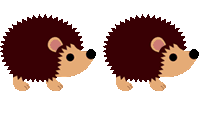
CAGE A well ventilated cage is required with at least 3 sq. ft. of floor space. Single level cages are best. Mostly commonly used is a guinea pig style cage or plastic storage tote. Aquariums and glass tanks are not recommended because they do not allow for enough ventilation and can easily hold moisture, which can cause upper respiratory infection. The cage should be kept up off of the floor in a well ventilated area that gets plenty of daylight.
BEDDING Carefresh bedding (unscented) makes excellent bedding. Aspen shavings (NOT CEDAR!) are also acceptable. Place one-two inches of bedding material evenly over the floor of the cage. Another option is a liner on the floor, such as fleece, that can be easily changed/washed every couple of days. Our hedgehogs are raised on shavings. HIDING PLACE Hedgehogs need a place to get away from the light during the day in order to sleep. This can be as simple as a piece of 6 inch PVC pipe, an igloo, or a fleece blanket/snuggle sack that can be changed/washed every couple of days. LITTER BOX & TRAINING Your hedgehog will usually use a litter box if you provide him with one. A small box that is about 2" deep, half filled with dust free cat litter works well. Non-clumping, unscented cat litter is the safest choice. You can also use the same shavings as the rest of the cage, newspaper or paper towels to line the bottom. It's commonly recommend to use a large enough litter box that the wheel will fit inside of.
FOOD & FOOD BOWL The food bowl needs to be fairly heavy to prevent your hedgie from dumping out its contents and using it as a toy. Small ceramic crocks that are designed for small rodents are perfect food dishes for hedgehogs. The width or diameter of the dish can be 2 to 4 inches and it should be no more than 3” high. If the dish is too large, the hedgehog will have to climb inside to eat, resulting in feces in the food. Filling the food bowl once per day should be sufficient for most hedgehogs. Take notice as to how much they did, or did not eat the day before and adjusting what you offer will help regulate his food intake and avoid waste.
FOOD Although there are hedgehog foods available in stores, it typically doesn't have good ingredients. When choosing food look for ingredients that start with a solid protein (example: "Chicken" vs. "Chicken Meal.") Protein should be 30-35%, fat under 15% and a minimum fiber of 4%. Typically high quality, indoor adult dry cat food formulas have these percentages. SECT Hedgehogs uses a dry kibble with the main ingredient being insects, the main protein is black soldier fly larvae. This food is available to our customers to purchase at pickup, and can be purchased for shipping on www.TheHedgehogStore.com. This food cannot be purchased in a store. Whatever food you choose can be supplemented by a variety of other foods such as mealworms and crickets, cooked meats. Hedgehogs can have up to 15 bugs per day in their diet. Fruits and vegetables should be given sparingly. Most hedgehogs prefer protein based food and treats. When switching foods mix 1/2 of the old food with 1/2 of the new food until old food is gone. Diarrhea is normal as your hedgehog adjusts to the new food. Dry Cat Food Recommendations: Chicken Soup for the Cat Lover's Soul (Indoor Hairball), Performatrin (Healthy Weight), Natural Balance (Indoor Ultra Rabbit & Salmon), Wellness Complete Health (Indoor Health), Natural Balance (Green Pea & Duck), 4Health (Indoor Cat Formula), Holistic Select (Indoor Health / Weight Control), Blue Buffalo Grain Free Freedom (Indoor, Chicken Recipe). Acceptable Treats & Supplements Unseasoned, cooked meats, unseasoned eggs: scrambled or hard boiled. Insects: mealworms, crickets, earthworms, wax worms, silk worms, phoenix worms, horn worms, hissing roaches, dubia roaches. Fruits: apple, banana, blackberries, blueberries, cantaloupe, cherry, cranberry, honeydew, kiwi, papaya, peach, pear, plum, pumpkin, raspberry, squash, strawberry, watermelon. Veggies: asparagus bell peppers, broccoli, carrot, celery, cilantro, corn, cucumber, green beans, green pepper, peas, spinach, sprouts, sweet potato, turnip, zucchini, leafy greens. Unacceptable Treats Freeze dried insects should only be offered in moderation: live is best. Avoid citrus or dried fruits, grapes/raisins, avocado, onion, rhubarb leaves, peanuts, pits and seeds, human junk food, chocolate.
WATER BOTTLE/DISH Hedgehogs love to fill open water dishes with shavings and this prevents them from getting enough water to drink. A common concern with water bottles is that hedgehogs can break their teeth or get their tongues caught. (I haven't ever had this happen). It is best to start off with both a dish and a water bottle. Take careful notice of which your hedgehog prefers before taking one away. All pygmy hedgehogs at SECT Hedgehogs are raised with a water bottle.
TOYS If you choose, you can also add a few toys for your hedgehog to play with. Small cat toys, toy cars and toilet paper tubes cut down the middle are great. WHEELS A wheel with a solid running surface is a must for a hedgehog’s habitat. Wheels with metal bars or mesh surfaces are difficult for them to use and sometimes get their legs and toes caught in. Hedgehogs do a considerable amount of exploring in the wild and the wheel helps provide the miles of exercise they require daily. Hedgehogs tend to not get off of their wheels to do their business, so you may need to clean the wheel daily. The best wheel options for hedgehogs are 10-11-12" in size and include the Comfort Wheel, Silent Spinner and Nutmeg Spinner Bucket Wheels.
TEMPERATURE & LIGHTING Your hedgehog should be kept indoors at a temperature of 75 to 78*F. Although the video below recommends a temperature as low as 72, I feel that 72 is too low because it can easily dip down even lower, endangering your hedgehog. Keeping a thermometer in the cage or using a thermostat/rheostat will help you regulate the temperature. Heat lamps and CHE bulbs are often used. A ceramic heat emitter (CHE) is a bulb that does not let off any light. Hedgehogs do need darkness at night and even the red or black bulbs made for reptiles can disturb their waking/sleeping patterns. They also need 12 hours of light during the day. Natural light is best, and keeping a lamp on for those few extra hours in the winter evenings is a good idea.
NAIL CLIPPERS, TOOTH BRUSH & BABY SHAMPOO & BATHING Hedgehogs do require that you clip their nails about once per month. The tooth brush is to gently brush his quills when you bathe him with just a little bit of baby shampoo in the water. This can be done once per month or less, so as not to dry out his skin. He can, however, have a “foot bath” as needed in a shallow tub to clean off his feet if he gets “poopy booties.
QUILLING Baby hedgehogs go through something called “quilling”. Essentially this is when they lose their small baby quills and grow adult sized quills. This happens several times when they’re young and can last between 2 - 4 weeks. ๏ First quilling - 4 weeks old ๏ Second quilling - 6 weeks old ๏ Third quilling (when they get their adult color quills) - 11 weeks old. It can happen during adulthood as well. During the quilling process your baby hedgie will probably be especially grumpy because it is painful for the new quills to break through the skin. You should be gentle when handling your hedgehog during quilling. Do not flip him onto his back or stroke his quills. During bonding time, just allow him to sleep in your lap or walk around on his own. Handling a lot during quilling is important in the bonding process, and once the quilling is over, you will have a friendly, happy, well adjusted hedgehog. To help alleviate irritation during quilling you can give your hedgehog a warm bath with oatmeal shampoo added to the water, or you can put some oatmeal into a sock, get it wet and squeeze the runoff into the water and onto your hedgie’s back. The warm water will both soothe the pain and help the new quills to come to the surface of the skin.
SOUNDS Hedgehogs are generally quiet animals. They are prey animals after all, but they do make some noises. As mentioned above, they hiss/pop/huff when threatened. When in physical pain and sometimes even in anger they will scream, almost like a rabbit does, but that’s a rare sound. They also make small chirping sounds, whistles and even purr when completely content or as a mating ritual. HUFFING / HISSING / POPPING This is usually the first thing people notice. Hedgehogs do all of these things when they are scared or threatened. It can be very intimidating for first time owners, but with patience and tenderness your hedgehog will warm up to you. Even when hedgies have been properly socialized they will still huff and puff when woken up, or are exposed to loud noises or quick movements. To calm your hedgehog you can gently rock him back and forth in your hands or stroke his quills while speaking softly to him. If needed, you can pick your hedgehog up with a soft blanket or towel.
BODY LANGUAGE & HANDLING Erect quills mean he is threatened, scared or angry. It is how they protect themselves. Try talking softly to him until he calms down. Completely flat quills mean he is calm and secure. When only the forehead quills are erect and forced low on the head it means your hedgehog is fearful. They do this a lot when there are sudden movements or noises. A hedgehog rolls into a ball to protect himself too, so generally this means he is on guard. Some hedgehogs sleep like this all the time, but when they are unafraid and comfortable they will sometimes sleep completely sprawled out in a “splat” position.
BITING/LICKING/CHEWING Hedgehogs are not rodents, so they do not need to constantly file their teeth down and do not need “chew toys”. Most of the time, if it seems like your hedgehog is chewing on something, he’s really just gnashing the object between his teeth to mix the taste with his saliva so that he can anoint with it. As for biting, hedgehogs do occasionally bite. When handling your hedgie make sure you do not have the smell of food on your fingers because your hedgehog will smell it and try to taste it. Generally, they lick before biting, so you can avoid the chomp most of the time. Usually, these “tasting” nips are quick and not very hard. Your hedgehog will soon notice that you are not food. Aggressive biting happens when your hedgehog is angry or being territorial. You want to put a stop to this type of biting as soon as you can because it can get worse with time and lead to bad socialization. If your hedgehog bites you, DO NOT stop handling him or he will quickly learn that biting means he will get left alone. Instead, lightly blow in his face and then try to calm him down by either stroking his quills or gently rocking him back and forth and speaking gently to him.
ANOINTING It is believed that hedgehogs anoint for two reasons - to better camouflage themselves with their surroundings and/or to build up a tolerance to toxins, but it is not known for sure why they do it. When hedgies smell something new and interesting they will sometimes start to foam at the mouth, torque their bodies into what almost seems like an unnatural position, and spread the foam over their quills with their tongues. It is quite messy, especially if they decide to anoint with something stinky.
PERSONALITIES & GENDER DIFFERENCES I firmly believe that the more you handle and bond with a hedgehog, especially at a young age, the friendlier they will be. With that said, here is a standard believed list of personalities you will see in hedgehogs. Snugglers: These hedgies love to cuddle up and snuggle. They always seem to want to find a warm, soft, dark place to get comfortable, whether it’s in your lap, in the crook of your neck or arm, or on your shoulder. Explorers: Some hedgehogs just love to explore and run wild. They’re curious about everything around them and sometimes don’t particularly like to cuddle. When out of their cage they just want to be free! Sleepers: Just like some folks, some hedgies are just lazy. They just want to lounge about and find soft places to sleep, but you should find ways to encourage exercise. Grumps: There are some hedgies that are constantly grumpy. It’s nothing personal, they just are. Sometimes these hedgehogs need a little bit more TLC than others, but even with extensive efforts at socialization they will still shy from being held or interacted with. That doesn't mean you should give up on them though. They deserve just as much love as snugglers!



Komentarze